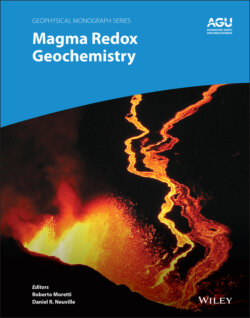Читать книгу Magma Redox Geochemistry - Группа авторов - Страница 52
Inferences about Mantle fO2 as a Function of Tectonic Setting.
ОглавлениеFrom the analysis above, we may conclude that neither degassing nor crystal fractionation can generate the increases we observe in Fe3+/∑Fe ratios as we move from the mid‐ocean ridge, to the back‐arc, to the arc‐front environment. The inability of these processes to greatly alter fO2 is evidenced by the fact that magnetite–ilmenite oxybarometry on volcanics, and spinel‐oxybarometry on the source mantle itself, also record increasing fO2 as we move from the ridge, to the back‐arc, to the subduction‐influenced forearc, to the arc‐front setting. We conclude from this evidence that the mantle source itself must become oxidized as the influence of subduction increases. Indeed, in situ work by Kelley and Cottrell (2009) and numerous studies since (Brounce et al., 2014; Brounce et al., 2021; Brounce et al., 2015; Kelley & Cottrell, 2012), have linked the fO2 recorded by submarine glasses and olivine‐hosted melt inclusions to enrichment in slab‐derived fluid‐mobile incompatible trace elements. However, it is critical to consider other lines of evidence, such as trace element proxies, that have been argued to be more robust proxies for mantle fO2 (e.g., Lee et al., 2005).
Figure 3.6 Magmatic oxygen fugacity as recorded by volcanics for samples in our compilation as a function of the crustal thickness (a) and SiO2 (b), and the molar ratio of SiO2/Na2O+K2O (c). We combine oxygen fugacities derived from melt inclusions with those from magnetite‐ilmenite pairs for each tectonic setting in each panel; we do not distinguish results based on method. Crustal thickness taken from (Behn & Grove, 2015; Calvert et al., 2008; Chulick et al., 2013; Darbyshire et al., 2000; Das & Nolet, 1998; Ferrari et al., 2012; Finotello et al., 2011; Janiszewski et al., 2013; Levin et al., 2002; Manalo et al., 2015; McGlashan et al., 2008; Nicolich et al., 2000; Saiga et al., 2010; Sevilla et al., 2010; Spieker et al., 2018; Syuhada et al., 2016; Takahashi et al., 2007; Veenstra et al., 2006; Watts & ten Brink, 1989).
We compare our Fe‐based oxybarometry results to those obtained from trace element partitioning. Several studies based on V/Sc, V/Y, V/Ti, V/Ga, Zn/Fe ratios, or Cu concentrations have concluded that the fO2 recorded by arc volcanics are statistically indistinguishable from those recorded by MORB (Lee et al., 2005; Lee et al., 2010; Lee et al., 2012; Mallmann & O’Neill, 2013); this study, and others, have reached the opposite conclusion (Bucholz & Kelemen, 2019; Laubier et al., 2014; Shervais, 1982). It is beyond the scope of this contribution to translate the V/Yb ratios we have compiled into fO2; however, the conclusion that V/Yb of MORB < BABB < arc basalts is robust (Figure 3.4). This implies that subduction‐modified mantle is more oxidized than the MORB source mantle, consistent with Fe‐based oxybarometry, for reasons that remain debated (e.g., Andreani et al., 2013; Benard et al., 2018; Canil & Fellows, 2017; Carmichael, 1991; Chin et al., 2018; Debret et al., 2014; Evans, this volume; Farner & Lee, 2017; Foden et al., 2018; Gaillard et al., 2015; Kelley & Cottrell, 2009; Lecuyer & Ricard, 1999; Lee et al., 2005; Mungall, 2002; Nebel et al., 2015; Parkinson & Arculus, 1999; Tang et al., 2018; Tollan & Hermann, 2019; Williams et al., 2004; Wood et al., 1990).
